Black Sand
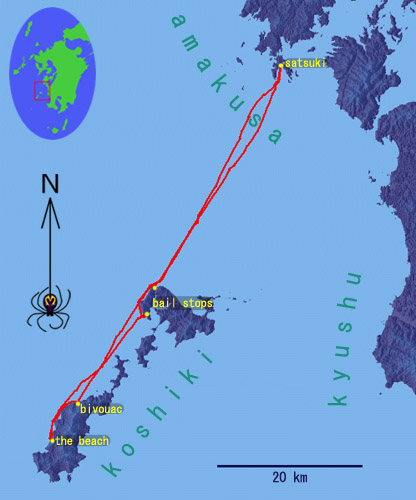
The time has come, the walrus said, to write up a few things, so I will tackle a favorite but as yet untold story, from a half-crazy time early last summer when Leanne went back to Canada for ten days to attend her sister’s wedding. Leanne and I are a pretty inseparable team, having spent virtually no time apart for the last five or six years. We work together, eat together, sleep together, have adventures together, always. So as we briefly parted ways, we both expected some fluctuations of the psyche. Hers, however, would be moderated (hopefully) by the presence of her family, while I was setting myself up for a real roller-coaster with a planned return to an old hobby of mine: the aquarium.
I used to keep tropical fish, aquatic plants and insects, and other such vermin throughout much of my elementary, junior high, and high school years. Having lived under the authority of my parents, and further, having to gainful employment at that time (save a short abortive stint as a waffle-maker at the Canadian National Exhibition which landed me a used VIC-20 computer that set off yet another life-changing chain reaction), I was limited to a small tank and cheap equipment and while I learned many fascinating things, I never had the feeling I was doing things right. Well, somehow I decided the time has come to rectify that, and a week alone was the perfect chance to mess up the apartment, run around shopping, etc. The conviction to do things right was paramount, and things quickly escalated into near-obsession status. My first round of shopping yielded shockingly little of what I needed and wanted, save for some fish and plants, which I kept alive and well for a while in the bathtub (some even laid eggs there which hatched into healthy fish I have since given away). Eventually I ordered what I needed on the Net. Every day was a whirlwind of research, endless net searches, ordering, canceling, re-ordering…I was having a great time. Finally, after a week, the dust was settling and all there was left to do was wait for the order to come in…and one final errand.
On a trip two years ago to Koshiki, an archipelago 40km south across the sea from Amakusa, I had thought absent-mindedly and yet prophetically as we landed on a beach of dark sand and gravel in a beautiful place with a waterfall: this would be the perfect sand for an aquarium. Fish, like most other creatures on Earth, get nervous about predators, and light substrates such as the sand commonly sold at aquarium shops make them stand out against the bottom when seen from above; the fish know this and live under constant stress. Black sand is therefore the best. What’s more, this Koshiki sand was beautiful: every pebble showed subtle patterns caused by melting together of the various layers that formed this metamorphic rock. It was not calcareous, and so would not affect the chemistry of the water; the few shell fragments it contained could be burned off with an acid soak. This was it: the perfect sand.
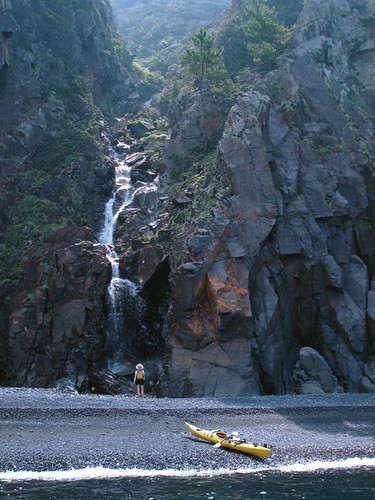
Leanne stops to admire the waterfall at 'the beach' in August 2005.
I could have gotten some rather expensive but suitable sand on the net, but would it be perfect? Most black sands available there looked like lava fragments which would be too abrasive for some of the bottom-dwelling fish I was planning to keep. So the present search for perfection was leaving me no option but to go back to this beach, though in the meanwhile I had forgotten where it was exactly. Initially, I planned to go by car and ferry, launching the kayak from a convenient local port, but as chance would have it, a storm was on the way heralding weather bad enough to shut down the ferry system during the only available travel window, possibly stranding me in Koshiki. My boss would likely take a dim view of this, especially because with Leanne gone, we were already short on staff. So the diabolical plot thickened: since it actually takes just as long to paddle there as it takes to go by ferry (due to the convoluted route), if I went by kayak I could start twelve hours earlier and beat the storm. To boot, I would save nearly 200 bucks in ferry tickets. And so it was decided.
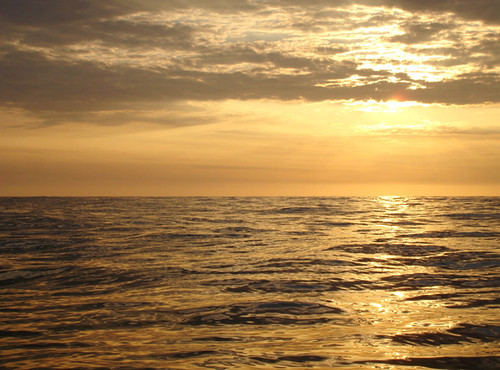
Not all that glitters is gold (and vice versa). Sunset on the sea halfway between Amakusa and Koshiki.
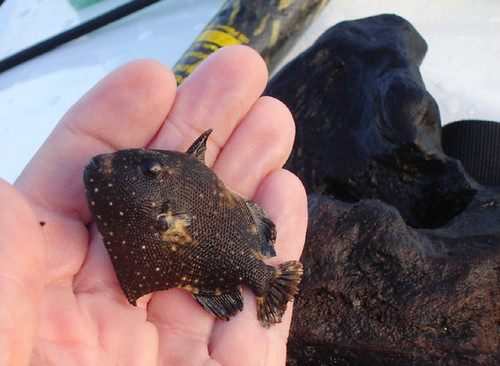
Floating on the open sea, I spotted an attractive piece of driftwood; after lifting it onto the deck I saw this baby leatherjacket swimming helplessly, deprived of his home. Without the drifting log to protect him, he would soon fall prey to bigger fish; resigned to his fate, he made no effort to escape as I scooped him up with the palm of my hand. He needed the driftwood more than I did, so I left it floating there for him.
As it happened, both the 40km traverse there and back was mismatched to the tidal currents, and the weather forecast was far from ideal. There was nothing to be done but to put up with it; anyway I had the wonderful Hayate which about canceled the effect of the sea currents. Looking at the GPS track from two years ago, I noted every place we landed, eliminated a few, and re-armed my GPS with the rest. I aimed straight for the first point, 60km distant, and arrived there around midnight after an uneventful 10-hour nonstop paddle, only to find large, white boulders. No matter; I set up camp and slept a few hours. I needed no alarm clock: I snapped awake at the first sign of dawn to find a stiff south wind blowing and the waves seeming larger than forecast. I might yet strand myself here, I thought. But soon I was fighting the elements, inching south against the wind in search of my treasure past sea cliffs that form the wildest and most beautiful coast in Kyushu. The vertical walls concentrated the wind to the point where I could only barely make it past the headlands. As Murphy’s Law would have it, the magic beach was the very last of the marked points. Looking more carefully at the geology, it was really a freak place: all the rock left and right was ochre or yellow compact sandstone; only a narrow band of black metamorphic cliff hung above a valley where a stream fortuitously eroded it and washed the precious debris over a waterfall directly into the sea. The beach was hardly a hundred meters long and were it not for the stream constantly recharging it with sediment, the sea would soon wash it away completely. As it was, sand and pebbles of all sizes were to be had, nicely pre-sorted by the waves!
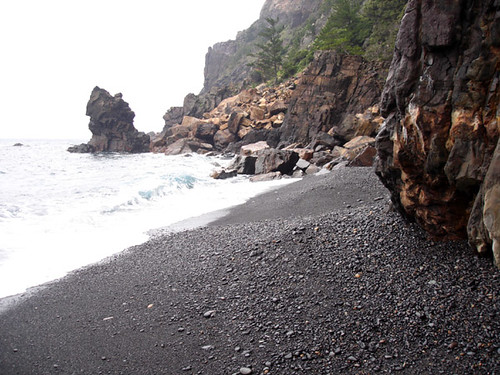
Back on the black beach. Two months and a typhoon later, we'd stop here yet again, to find most of the sand washed away.
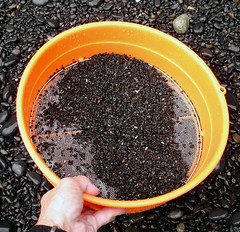 I spent several hours sifting my black gold further until I had about 50 kilos of just the right size pebbles. Loading the sieve with sand, I would walk directly under the waterfall and let the powerful stream do the sifting for me. What I was doing seemed to have great beauty and harmony: a man intently at work in his natural environment. I knew then all was right. But when I loaded it all into the boat, along with a few large decorative boulders, and pushed the now incredibly cumbersome craft into the water, I was surprised to see the stern completely awash! Shucks, I was going to have to leave some precious cargo behind! This I did and rebalancing the boat, I was able to get it to float level but with the seas right up to the gunwales. Thusly, I set out on the return trip, and with the wind and waves pushing me along, the overloaded boat still wallowed forth at reasonable speed. The weather socked in further, and soon I was enveloped by fog. It was during the 7km open traverse between the two main Koshiki Islands that I noticed the stern was again riding a little low. It was hard to judge in the rough water, but with even the smallest waves washing over the low-riding deck, water was probably seeping in through the hatches. Paranoid thoughts then gripped me – this way I certainly could not chance the full traverse to Amakusa: if the stern sank completely I would have no way to remedy the problem! I would have to jettison some more cargo. I landed as soon as a shore came into view; this was all exposed to the waves so it was a bit of a crash landing really. I could barely heave the boat half-clear of the surf. Sure enough, the back end was flooded. I dumped some more sand and boulders, pumped out the bilge, and this time loaded a good quantity of cargo right into the cockpit. It was a tight fit but if in a panic I could now jettison ballast en route. Relaunching, I came around the rest of the island, then landed again to check for leakage. There was some, but it seemed all right. A final pumping and off I went, committing myself into the mists of the roiling East China Sea, with darkness also slowly descending.
I spent several hours sifting my black gold further until I had about 50 kilos of just the right size pebbles. Loading the sieve with sand, I would walk directly under the waterfall and let the powerful stream do the sifting for me. What I was doing seemed to have great beauty and harmony: a man intently at work in his natural environment. I knew then all was right. But when I loaded it all into the boat, along with a few large decorative boulders, and pushed the now incredibly cumbersome craft into the water, I was surprised to see the stern completely awash! Shucks, I was going to have to leave some precious cargo behind! This I did and rebalancing the boat, I was able to get it to float level but with the seas right up to the gunwales. Thusly, I set out on the return trip, and with the wind and waves pushing me along, the overloaded boat still wallowed forth at reasonable speed. The weather socked in further, and soon I was enveloped by fog. It was during the 7km open traverse between the two main Koshiki Islands that I noticed the stern was again riding a little low. It was hard to judge in the rough water, but with even the smallest waves washing over the low-riding deck, water was probably seeping in through the hatches. Paranoid thoughts then gripped me – this way I certainly could not chance the full traverse to Amakusa: if the stern sank completely I would have no way to remedy the problem! I would have to jettison some more cargo. I landed as soon as a shore came into view; this was all exposed to the waves so it was a bit of a crash landing really. I could barely heave the boat half-clear of the surf. Sure enough, the back end was flooded. I dumped some more sand and boulders, pumped out the bilge, and this time loaded a good quantity of cargo right into the cockpit. It was a tight fit but if in a panic I could now jettison ballast en route. Relaunching, I came around the rest of the island, then landed again to check for leakage. There was some, but it seemed all right. A final pumping and off I went, committing myself into the mists of the roiling East China Sea, with darkness also slowly descending.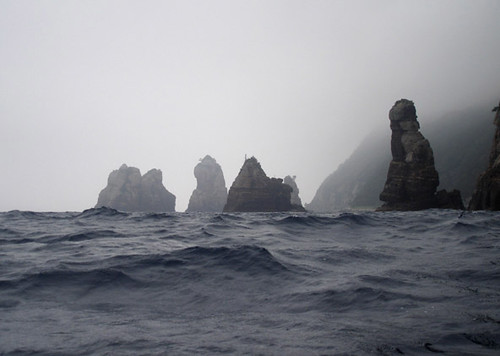
The coast takes on a somber appearance on the return trip.
But everything went well. In fact, the weather calmed a bit and the feared storm never materialized. With smoother water, leakage into the rear hatch was no longer a problem. Only the tidal countercurrent and the slowness of the overloaded boat remained to deal with, so I brought a little muscle power to bear. To break up the monotony, I pulled out the FM radio and listened to a special program – it was, as if by coincidence, the Day of the Sea, one of the Japanese national holidays. There was some music and comedy skits that I actually found kind of funny. And then, just before midnight, with the lights of Satsuki reflected in the waves before me getting brighter by the minute, I had a truly cheesy moment. The program finished with a song by an Okinawan soft rock band that, along with Okinawan music in general, has become very popular lately. The DJ helpfully explained that since Japan is all islands, you don’t have to be from Okinawa to understand, to wit:
About the sea of this island where I was born,
How much do I really know?
That it’s getting dirtier,
The coral’s dying, the fish too,
Don’t know what we ought to do
But I know more than anything,
Covered with sand, rocked by the waves,
In this sea that's slowly changing
There's surely a treasure here,
One that you can’t see on TV
Or hear about on the radio
This is the islander's treasure...
It was pretty hard work to haul all my treasure up the stairs from the beach.
To be continued…
Labels: kayak expedition シーカヤック遠征


0 Comments:
Post a Comment
<< Home